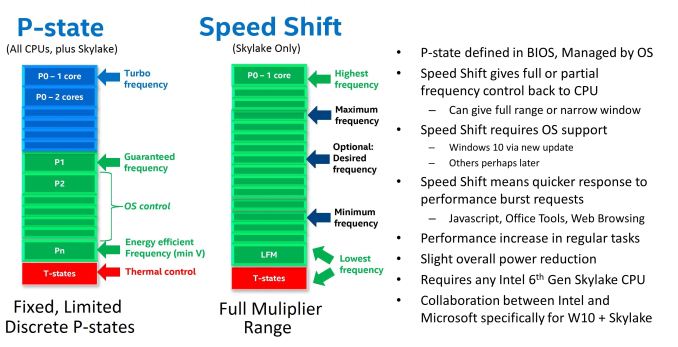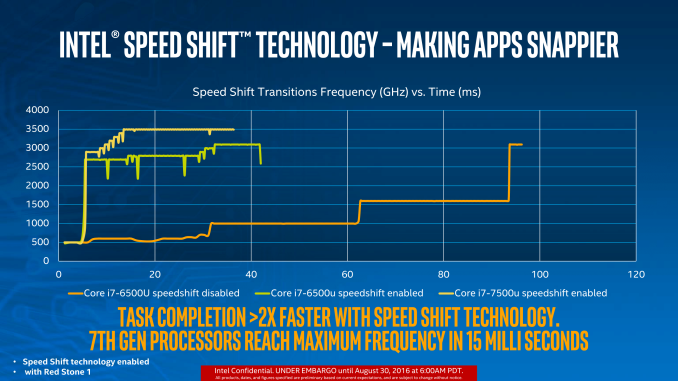The Intel Core i3-7350K (60W) Review: Almost a Core i7-2600K
by Ian Cutress on February 3, 2017 8:00 AM EST7th Generation New Features
One of the big questions regarding the launch of Intel’s 7th Generation of CPUs was around what extra features the new platform brings, especially if there isn’t any clock-for-clock performance improvement. As with our other Kaby Lake reviews, here we explain the main two: Speed Shift v2 and Optane Memory support.
Speed Shift v2
For the Intel’s 6th Generation of processors, Skylake, they introduced Speed Shift (v1). This was a feature that, at a high level, gave control of the voltage/frequency curve from the operating system to the processor. Using a series of internal metrics, such as instruction analysis and frequency, the CPU would automatically adjust the voltage and frequency of the processor as required. This afforded two major benefits: one, with the CPU in control it has access to many more points on the curve compared to the OS which is limited to specific P-states on the processor.
The second benefit is the speed of transition. A processor that can ramp up to a high frequency quickly and then drop down as needed can get through instructions quicker but also save power. Imagine driving a car, and having to wait 60 seconds to change a gear – it’s that sort of analogy.
What Speed Shift v2 does in the Kaby Lake family, compared to v1 in Skylake, is manage those transitions to higher frequency faster. Before Speed Shift, transitions from idle to peak turbo were on the order of 100 milliseconds, and Speed Shift v1 took that to 30 milliseconds (with a good base established within 15). Speed Shift v2 means that peak performance from idle now happens in 10-15 milliseconds total. This means that interactions with the OS, such as touch, or actions that rely on low latency, can occur within a couple of frames on a 60 Hz display.
The benefit of Speed Shift lies a lot in touch devices, which perhaps doesn’t affect the desktop Kaby Lake processors in this review, but also in web interactions. A lot of web work is stop and start, such as scrolling or javascript functions.
There is one caveat however – Speed Shift currently only works in Windows 10. It requires a driver which is automatically in the OS (v2 doesn’t need a new driver, it’s more a hardware update), but this limitation does mean that Linux and macOS do not benefit from it. I would be hard pressed to not imagine that Apple and Intel were not working on a macOS driver, but as yet we have not had confirmation that one exists.
Optane Memory Support
The latest memory technology to hit prime time is Intel and Micron’s 3D XPoint. This is a non-volatile form of data storage that is bit addressable and can be used as DRAM or storage. Despite being at least a decade in the making, and being formally announced in 2014, it is still yet to show up commercially as it is still being developed. Intel plans to create 3D XPoint DRAM that is slightly slower than normal DRAM but both denser (more of it) and non-volatile (keeps the data after power loss, saves power altogether), as well as 3D XPoint Storage that is faster than standard NAND flash, and more configurable. It the scheme of things, we expect the storage based products to hit the market first.
Intel, as far as we can tell, is set to release two main classes of product: Optane DRAM to be pin-compatible with DDR4 and require Optane DRAM enabled processors, and Optane SSDs which should work with any PCIe storage interface. ‘Optane Memory’ however, is something a little different. Based on pre-briefings, Optane Memory is certainly not Optane SSD we were told, but rather a storage cache for mechanical hard-drives. We’ve had this before with NAND flash drives, using Intel’s Rapid Storage Technology, and it seems that Kaby Lake and 200-series chipsets will support a new version of RST for PCIe based storage. But because this is caching drive, such as the 16GB Optane Memory drives in Lenovo’s upcoming notebooks, and not Optane SSD, might lead us to believe that ‘Optane Memory’ drives are not designed to be directly user addressable.
All that being said, Intel has stated that Optane Memory standalone drives should hit the market nearer Q3 for general consumer use, which is more in-line with what we might expect to see with Optane SSDs in the enterprise space.













186 Comments
View All Comments
realneil - Wednesday, February 8, 2017 - link
^^This^^Intel is ~finally~ facing some upcoming opposition in the CPU arena and they're trying to fill in some perceived gaps in their CPU lineup.
After Ryzen is released, expect to see multiple product changes from team blue right away to combat AMD's offerings.
CaedenV - Friday, February 3, 2017 - link
I think it will make more sense with next gen parts. I suspect we are watching a shift in the lineup that is slowly rolling out.celeron - duel core
pentium - entry duel core with HT (limited cache/clock/iGPU)
i3 - high-end duel core HT (essentially unchanged)
i5 - quad core with HT (today's i7)
i7 - 6-12 core with HT (today's LGA2011 line)
So why no straight quad core part? Well, 2 reasons.
1) it probably isn't needed. The original i5 parts were just i7s with broken HT cores that were disabled. I imagine most chips coming out now have perfectly fine HT cores, so they are artificially disabled. This increases the cost of the binning process, and reduces profit on a per-chip basis... especially if they can sell the same part somewhere between today's i5 and i7 price.
2) Right now I would wager that most home builders buy either an i3 because they are budget conscious, or i7 because their pride will not let them get anything less than the best. But the i7 that they buy is the lower margin 'consumer' i7 chips rather than the premium laiden LGA2011 i7 chips that make buku bucks on both CPU and chipset sales. Moving the i7 lineup to start at ~$500 instead of ~$280 would more than off-set the number of people willing to step down to an i5 chip; even if the step down is in name only and really the i5 would be more affordable while offering traditionally i7 performance levels.
3) Bonus reason; Ryzen chips are expected to land near today's i5/i7 chips in performance, and Intel does not want AMD to be able to say 'our chips are as fast as an i7 but only cost what an i5 does'. Instead, intel want's it's smug users (like myself) to say 'ya, that Ryzen is not a bad chip, but it doesn't hold a candle to my i7'. Real world benchmarks be damned, it is what people are going to say.
Alexvrb - Friday, February 3, 2017 - link
I wouldn't necessarily bet that more home users buy i7s than i5s. I personally know two gamers that recently built i5 systems because they wanted more oomph than a 2C/4T i3, but didn't want to spend money on an i7. Why? So they could spend more money where it makes the biggest difference... the graphics card. An i5 provides plenty of CPU horsepower for games, and gives you another $100 or so to spend on better graphics.I think their judgement was sound. I doubt they are alone in this kind of assessment. I think you're letting your admitted i7 smugness cloud your judgement a little bit.
Tunnah - Saturday, February 4, 2017 - link
I build PCs for my friends, and advise people on what to buy, and I don't know a single person apart from myself who has an i7 (and only know of 1 person who has an i3 but he uses his box for media). i5 is a perfect chip for casual users who use the PC mostly to game.Hell the only reason I have an i7 is for Civ VI ha.
Alexvrb - Saturday, February 4, 2017 - link
Bingo!Meteor2 - Sunday, February 5, 2017 - link
i7s (or Xeons) are nice if you're encoding a lot of x265 video (x265 gives better quality per bitrate than hardware encoders). That's the only desktop use case I can think of.Meteor2 - Sunday, February 5, 2017 - link
...or apparently not, according to a comment way below, where a 12C/24T Xeon barely does double digit x265 FPS.bak0n - Monday, February 6, 2017 - link
Exactly why I have an I5 3570k. My next build will either be a ryzen (depending on wither it hits expectations), or the I5 of whatever generation is out when I'm ready to buy. To big of a price jump to the I7 for a hard core 1080P maxed setting gamer, but not to much of a price jump over the i3's. That is, until now with the i3k which I may actually give a second look at.DiHydro - Monday, February 6, 2017 - link
I fit into that category with one caveat, I also do some 3d modeling and rendering. This pushed me to the i7-2600k about four years ago, and I still don't feel that my CPU is the limiting factor on my PC.Byte - Saturday, February 4, 2017 - link
Very true, most customers want the best or the cheapest. Changing the lineup liek that would make it easier.